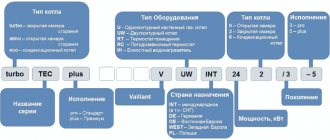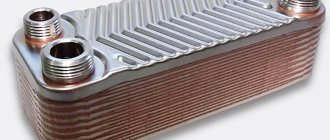Here you will learn:
- Disadvantages of gas heating
- Why services don’t like autonomous heating for residents
- Safety of gas boilers in apartments
- How to switch to gas heating
- Autonomous heating installation diagram
- Arranging a room for installing a gas boiler
- Requirements for chimney installation
- Gas boilers for heating an apartment - basics of choice
Before installing autonomous heating in an apartment, you need to know its main advantages. They are related to both operational and structural characteristics. The advantages are as follows:
- an autonomous gas boiler room reaches operating mode as quickly as possible;
- the real efficiency of most systems reaches 95%, which is one of the best results among analogues;
- compact dimensions allow you to fit everything in any kitchen or bathroom, without allocating a separate room for a gas boiler in the apartment;
- relatively cheap fuel is used;
- it is allowed to start autonomous heating in an apartment building at any convenient time when the owner needs it, in contrast to starting central heating according to the schedule;
- effective gas automation is used on an old or new boiler;
- quick payback.
A well-designed heating circuit will ensure a long period of uninterrupted operation.
At any time, the owner of an autonomous heating system in an apartment can increase/lower the temperature of the coolant independently in order to provide the home with heat or save on gas consumption. Using a double-circuit boiler, it will be possible to minimize the cost of providing hot water supply.
Disadvantages of gas heating
In addition to the positive qualities that the apartment owner receives individually, the heating system of the house as a whole receives a certain imbalance. This is due to the fact that a large residential facility was designed for operation with hydraulic equipment installed in it. In addition to problems with loss of thermal balance, physical violations of building codes and regulations during equipment installation are common.
The greater financial burden of maintaining heating mains or boiler houses falls on fewer people, which leads to an increase in the cost of central heating for them.
An imbalance leads to the fact that heating occurs unevenly in different apartments; in some places you can’t get close to the radiators due to the heat, and in others the sections are not warm enough. In addition to these aspects, air pollution is increasing. Every boiler releases harmful gases into the atmosphere, which leads to pollution. Often carbon monoxide can enter the room through an open window located next to the heating pipe.
Gas heating in an apartment in an apartment building is the best heating option combined with an affordable price and ease of operation of boilers. The main thing that is required from the consumer is to choose the right boiler, entrust its installation to specialists with a clearance category and carry out annual maintenance. For any problems with gas equipment, the appearance of uncharacteristic noises and especially odors, call the emergency service or invite a gas technician.
general information
You should prepare for the fact that the heating supply organization will be against installing autonomous heating, because Almost throughout the entire territory of Russia, it is prohibited to disconnect an individual apartment from the central heating supply and switch it to an autonomous one (an exception is if the transition is carried out by the entire house). There are quite understandable reasons for this, such as:
- An installed individual boiler can unbalance the entire heating system of an apartment building, which will “suffer” neighboring apartments;
- The hydraulics of the system will be disrupted;
- Often, to install autonomous heating in a separate apartment, it is necessary to increase the diameter of the gas supply pipes, because otherwise, the pressure in the system may drop, which in turn will lead to malfunctions of gas stoves;
- There is no guarantee that the apartment owner will comply with all necessary security requirements;
Also, before installation, you should pay attention to the presence of a chimney system in the house, which is mainly present in old houses. Unfortunately, in modern houses ventilation is provided only in the bathroom, toilet and kitchen
Important! It should be remembered that if you managed to install autonomous heating, you must periodically clean the chimney, which becomes clogged with soot, which negatively affects the efficiency of the gas boiler
Gas wall-mounted boiler Bosch Gaz 4000W. ZWA24-2A23 S5700
Why services don’t like autonomous heating for residents
As a rule, all heat supply organizations are opponents of autonomous heating in apartment buildings, especially if from the very beginning the house was designed specifically for centralized heating. If one of the residents installs an autonomous boiler, this will unbalance the internal heating system of the entire residential building.
In addition, sometimes separating and installing your own gas heating in an apartment in post-Soviet countries is accompanied by violations of safety requirements and documentation.
As a result, it turns out that the one who separated remains in economic benefit, and the remaining residents only suffer from this.
One of the disadvantages is the violation of hydraulic balance. So, it turns out that in some apartments the rooms are very hot, while in others, on the contrary, they are cold. Therefore, heat engineers have to intervene and adjust the heating system.
In addition, there is also an environmental aspect. It is very good if individual gas heating in the apartment was installed in a building that has an old structure - that is, the presence of a chimney is provided. But in modern multi-storey buildings there is no such kind of ventilation: ventilation ducts are only in the kitchen and bathroom.
Autonomous heating in the apartment
Typically, residents install chimneyless gas boilers that have a coaxial pipe through the wall under the window. Gas combustion products are usually discharged through the pipe. And this leads to the fact that gas combustion products (carbon, carbon monoxide, a combination of sulfur, oxides) enter the apartment owner or his neighbors through the open window. Even though many modern boilers are equipped with a closed combustion chamber, this fact cannot be ignored.
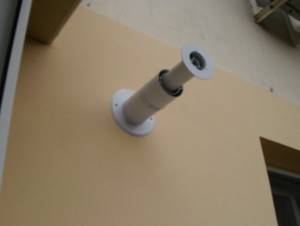
Parapet boiler chimney
What types of boilers are there for individual heating?
There are many types of heating units that can be installed in apartments:
- Single-circuit boiler.
This device is only suitable for heating a room. If you also need to heat water for family use, then such a unit will not be suitable. Of course, you can install it, but you will also have to additionally purchase a boiler to heat the water, and this, in turn, is fraught with extra costs. - Double-circuit boiler.
This heating unit is the most popular, since thanks to it you can also use hot water around the clock. The dimensions of such boilers are quite compact, so they can be installed even in a small kitchen.
If you choose from these two options, then, of course, the second option will be the best. Individual boilers in apartments are installed on the walls, which saves usable space in the kitchen. Many modern high-rise buildings do not have chimneys. But this is not a reason to give up on your dream - installing a gas unit. After all, there is another excellent way through which combustion products are removed outside. This is the installation of a coaxial pipe, or it is also called a coaxial chimney.
Gas boilers can have an open combustion chamber or a closed one. For an open chamber, a chimney is a prerequisite for installing gas heating in apartments. If an individual heating unit has a closed combustion chamber, then a coaxial pipe can be installed to remove combustion products, which simultaneously supplies oxygen to the combustion chamber and removes unnecessary substances through another hole.
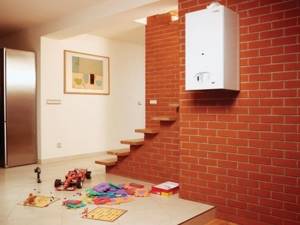
Rice. 2 Gas heating in the apartment
What are the benefits of boilers with a closed combustion chamber:
- Such units for individual heating are safer to use for others, as they prevent combustion products from entering the room.
- They are easy to use and have a much longer service life.
Also, many gas heating units only work when there is electricity. Therefore, if you live in an area where electricity often goes out, then you need to acquire an additional power source. After all, you don’t want to freeze in severe frosts.
Safety of gas boilers in apartments
Nowadays, manufacturers offer many boiler options. If you follow the operating rules, then they are all safe. But every boiler that uses autonomous gas heating in an apartment is serious equipment that requires adjustment and constant monitoring of its operation.
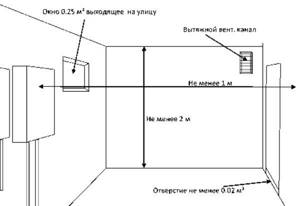
Minimum requirements for installing a gas boiler
If your apartment does have a chimney, then after some time soot will accumulate there. It must be cleaned at least once a year. If this is not done, the efficiency of the boiler will significantly decrease and the release of substances will increase. For example, if a new boiler emits one of these substances, then one that has worked for several years without cleaning will already emit two.
Individual heating in the apartment
Today, each boiler is equipped with automatic combustion and safety automatics. The latter is designed to turn off the gas supply if the pressure is low, and after the pressure is restored, the boiler should not start on its own without purging.
It often happens that after several attempts an error is displayed. And if the boiler is relatively old, then such a system may not exist. Such a boiler will require ventilation and manual start. If the automation does not work, gas contamination of the boiler and room may occur. There are many organizations involved in the installation and maintenance of boilers, so you should not try to fix it yourself, even if you think you can see what is wrong or wrong.
Boiler selection

To heat a room efficiently, you need to choose the right energy source. It is desirable that the supply of fuel to the boiler be constant.
The simplest solution is to install a solid fuel stove burning coal or wood. There is no need to obtain permission to construct such a structure. In addition, there is no need to connect to a water supply system. The closed circuit is filled once, and then water is added in small portions as it evaporates from the expansion tank. The disadvantage of this option is regular cleaning of the chimney and rapid burning of fuel. The way out of the situation is to buy a long-burning stove. At one gas station, a good fireplace works for up to 12 hours. You should constantly monitor the availability of coal and firewood, regularly replenishing their supply.
Electric boilers are distinguished by their compactness and clean heating process. The energy you receive is limitless, you just need to pay your bills on time. In case of a blackout, you can buy a small generator that has a place on the balcony or in the closet. The downside is that electricity is expensive, the heating season will cost a pretty penny. Therefore, such systems are in most cases installed in non-gas high-rise buildings.
Gas boilers are the most suitable choice for creating an individual heating system. The products are reliable, small in size and high in performance. The devices are completely safe thanks to automation, which turns off the gas supply when its pressure drops to a certain level. The downside is that you need to drill a hole in the wall to lead the chimney to the street. This negatively affects the strength of load-bearing structures and the aesthetics of the facade.
How to switch to gas heating
The constant struggle with the problems described above forces you to take the first step towards installing an autonomous system. It makes sense to think in advance about how to install gas heating in your apartment in order to calculate the cost of purchasing equipment and get an idea of the upcoming work.
First, document that there are real problems. To do this, you need to submit the appropriate applications to your heat supplier and the sanitary and epidemiological station.
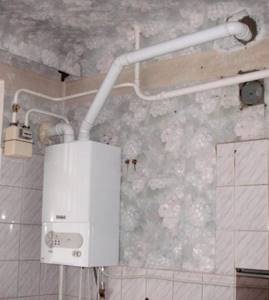
In most cases, heat supply organizations are against autonomous heating. Some houses were designed directly for centralized heating. Disconnecting residents from the system leads to system imbalance
These preliminary actions will help to challenge in court a possible refusal to install individual heating. Issues of this nature are often resolved in court.
To facilitate the process and gain confidence that you are right, you need to familiarize yourself with several regulatory documents.
For residents of the Russian Federation, this list includes:
- Federal Law 190-FZ “On Heat Supply” dated July 30, 2010;
- Decree of the Government of the Russian Federation No. 307, explaining the rules and features of the provision of utility services to residents;
- Articles 25 and 26 of the Housing Code of the Russian Federation: explaining the features of the reconstruction and redevelopment of premises in apartment buildings and the grounds for their implementation.
Judicial practice shows that there are many precedents for successfully challenging unfounded refusals.
Refusal from central heating supply
The text of Federal Law No. 190 specifies a list of individual heating sources that are allowed for installation in apartment buildings, as well as a list of devices prohibited for various reasons. The law, therefore, does not prohibit the use of modern gas boilers that meet the requirements.

To disconnect from the central system, you must prepare a lot of documents. Some owners are shocked by the time and amount required to implement their idea. Even though the fight will be difficult, autonomy is worth fighting for
According to Article 26 of the Housing Code of the Russian Federation, it is necessary to collect a whole package of documents to carry out the reconstruction of residential premises. This includes:
- A properly completed application for the need for reconstruction from the owner or responsible person;
- Original technical passport for the apartment;
- Copies and originals of notarized documents establishing the right to own and dispose of housing;
- The original of the developed project for the reconstruction of a residential apartment;
- Written consent of all family members and other residents registered in the premises;
- Conclusion of the authorities involved in the protection of architectural monuments on the admissibility of reconstructing the premises.
The structure providing central heating services has been considering the application for some time. It issues a letter with permission to disconnect the apartment from the central system. This document will be required when ordering technical specifications for the installation of individual gas heating within an apartment building.
The application for ordering technical specifications is submitted to the gas industry. The answer is usually given within ten days. A refusal can be obtained in cases where there is no gas in the region, it is impossible to purchase it in cylinders or regularly replenish the supply of blue fuel in the gas holder.
After formalizing the refusal of utility services in the field of heat supply, old and inefficient systems should be dismantled. To do this, you need to have a project to disconnect from central heating.
The basis for drawing up the project is a letter from the Homeowners Association with permission to terminate the use of the services of the heat supply organization. Be sure to receive a written response and save it. If you refuse this letter, you can go to court to appeal.
Having received the project documentation in your hands, you need to go with it to the regional branch of the All-Russian Voluntary Firefighting Society. After all checks, they issue a fire safety certificate for the project. If the need arises, a design for the chimney is also made there.

Sometimes the city administration delays the approval procedure. In this case, it is necessary to write an application addressed to the head of the administration to speed up the process. If after this you have not made progress, then consider going to court.
All documentation must be approved by the city administration. The conclusion on approval or refusal is accepted within forty-five calendar days from the date of its submission.
A refusal to renovate an apartment in an apartment building is issued on the basis of Article 27 of the Housing Code of the Russian Federation if the owner has not provided all the required documents. An unjustified refusal can be appealed in court.
Preparation of documentation and obtaining approval for the refusal of central heating supply. This is an initial preparatory step towards the legal transition to an individual gas heating system.
The list of required documents differs depending on the region and the specifics of the law. Comprehensive information can be obtained by consulting your city administration.
Permission to install a gas boiler
To successfully install a gas boiler, a number of formalities must be observed. First of all, you need to submit an application for the need to install an individual gas system in the city gas supply.
At the same time, you need to obtain a document confirming the serviceability of the ventilation and chimney. It is requested from the fire department.
Each neighbor must give their written consent to your desire to install an autonomous system. This measure is necessary due to the fact that when one or more apartments are disconnected from central heating, some malfunctions in the operation of the heating system may occur for the remaining residents of the house.
So, some apartments may begin to receive more heat, while others, on the contrary, less.
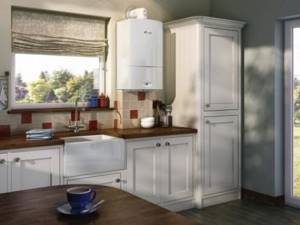
Installing a gas boiler without approval, technical specifications and design can lead to equipment damage, physical injury and litigation. Treat all gas appliances in your home responsibly
This problem is due to the fact that most heating systems in apartment buildings are outdated many years ago and require constant maintenance.
Next, you should recognize the manager by pipes and batteries. If they are managed by a household, then it is necessary to obtain permission for dismantling from neighbors. If they are subordinate to a government organization, then you need to write a statement to this company with a request to disable the systems.
After receiving all the documents and permits, you must contact the city heating network and get permission to draw up and approve a scheme for the future autonomous heating.
When the entire list of documents has been received and all previous stages have been completed, you can proceed directly to the dismantling of old communications. Typically, collecting the required papers takes from three to six months. Before submitting a technical certificate for the boiler to the gas organization, you should select the equipment model that is suitable for your apartment.
Boilers are single-circuit and double-circuit. Double-circuit gas units provide residents not only with heating, but also with an uninterrupted supply of hot water. This allows you to save gas and reduce service costs. Modern oversized devices have closed combustion chambers.
This design simplifies installation and eliminates the need for a gas duct. A special fan drives air from the street and then releases combustion products back through pipes installed for this purpose.

The design of gas boilers is light in weight and size. The boiler is installed on mounting strips on a load-bearing wall if all requirements for the room are met. Usually the boiler is connected to the gas main using metal pipes
The advantages of gas boilers include a multi-level security system, which includes an automatic system shutdown function. A number of sensors monitor the draft force and the presence or absence of flame.
A safety valve monitors the fluid pressure in the system and, if the norm is exceeded, is responsible for draining the excess fluid. The expansion tank allows you to control the expansion of the liquid when heated. The air vent is responsible for removing excess air from the system.
Sample list of documents
Since installing your own heating system refers to the refurbishment of a residential premises, the list will include:
- an application drawn up in a special form;
- documents establishing the right to own housing: state registration certificate, deed of transfer of ownership, gift agreement, document confirming the right of inheritance (originals or copies certified by a notary);
- certified copies for each owner and a statement signed by all owners (if the apartment is in shared ownership);
- a copy of the technical passport of the premises;
- consent of family members of the tenant and residents of the apartment building, documented in the form of minutes of the meeting of apartment owners (if the area is municipal);
- conclusion of the body responsible for the protection of architectural monuments, historical or cultural heritage on the possibility of redevelopment (if the house is an architectural, cultural or historical value).

The most difficult thing will be to prepare and provide technical documentation. These include:
- redevelopment project for the installation of a gas boiler, including gasification of the premises and changes to the central heating system;
- a copy of the passport for the electric boiler, technical conditions, agreement confirming the permission of the maximum power, which exceeds the capabilities of the boiler (when choosing an electric heating device);
- Specifications for disconnecting the wiring in the apartment from the communal heating system;
- Specifications for ventilation;
- Specifications for supplying gas networks.

Design and installation of an autonomous system
At this stage, the apartment owner, together with the designer, carry out the necessary calculations and decide what kind of individual heating system will be in the room. Depending on this, a gas boiler suitable in terms of power and characteristics is selected.
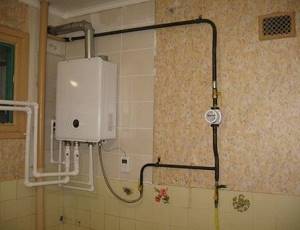
After installing a wall-mounted gas boiler, you should connect the coolant heating circuit to the installed heating system. The operation of the boiler is controlled by automation and a thermostat connected to it; the circulation pump built into the column is responsible for the movement of the coolant.
According to the rules, the required power is 100 W per square meter of area. This value is quite enough even for corner apartments, connected by many common walls with neighbors, which guarantees no heat loss.
The wiring, that is, the diagram according to which all heating devices and connecting pipes are located, depends on the type of boiler chosen and the principle of coolant movement: natural or forced. The layout is chosen at the design stage. It can be single-pipe or double-pipe, horizontal or vertical, top or bottom.
In addition to the diagram of the new autonomous system, the content of the project should include a section containing data on the dismantling of the old heating system. It specifies the details of disassembling and removing batteries and connections. It should be taken into account that the risers running through the apartment cannot be dismantled and must be insulated.

Before initiating a refusal from central heating and hot water supply, compare all the pros and cons of an individual system. Only after making the calculations, start collecting all the necessary documents
The individual heating scheme of your apartment must correspond to the possibility of installing radiators with thermostatic valves at the inlet. Conventional aluminum structures are suitable for this purpose.
If desired, the owner of an apartment on the ground floor has the opportunity to design a system of water heated floors simultaneously with autonomous heating. For owners of apartments located above, this option is not available, since the floors are not designed to support the weight of the system with coolant and concrete screed.
If the construction of a water floor heating system is approved, even on the first floor, separate procedures are envisaged to strengthen the lower floor by installing additional supports in the basement.

Perhaps after design it turns out that it is necessary to install new radiators. Despite the high cost of modern radiators, their quality plays an important role in the transfer of heat into the room. Therefore, it is better to choose high-quality models
If your home experiences periodic power outages, then you should consider purchasing an uninterruptible power supply. Thanks to the BPS, your gas boiler will work without interruption and continuously provide your apartment with heating and hot water.
How to refuse according to the law of the Russian Federation
Disconnecting a home from central heating is a time-consuming and costly process. To do this correctly, it is necessary to comply with the requirements of the law and step by step go through the difficult stage of project approval.
List of questions needed to be resolved
To turn off the heating you must:
- gain the approval of neighbors;
- obtain permission for reconstruction;
- contact specialists to create a redevelopment project;
- agree on the project;
- collect a package of documents;
- technically implement the plan.
When deciding to switch to individual heating, you need to decide which one. Since clause 15 of Art. 14 of Federal Law No. 190 of July 27, 2010 “On Heat Supply” prohibits the transition to individual heating in an apartment building when using thermal energy sources, the list of which is approved by Government Decree.
Neighbor permissions
In this case, the neighbors must allow the innovation; the issue is discussed at a meeting of residents.
When communications are not property of the house, the opinions of neighbors do not matter. You can immediately proceed to obtaining permission from relevant organizations. It will be necessary to make changes to the technical passport of the house.
Documentation
Article 26 of the Housing Code of the Russian Federation gives owners the right to disconnect from central communications. To do this, you need to collect a package of documents:
- Statement. It is written in free form; it needs to state the request to disconnect the apartment from centralized heating and justify it.
- Technical passport of the living space.
- Certificate of ownership.
- Written consent of adults living in the apartment.
- Conclusion on the technical feasibility of such changes.
- Coordinated reconstruction project.
Reconstruction project
The document on redevelopment of the heat supply of an apartment or house is carried out by a design organization or institute with the appropriate license on a contractual basis. To do this, use professional instructions and comply with the requirements of the law. Specialists will make calculations and monitor the effect of the apartment’s heating elements on the heating of the house.
Thermal-hydraulic calculations and calculations of residual heating from risers and sunbeds are also performed.
If, according to the results, installation of a separate boiler is possible, the project should be submitted for approval. If experts admit that canceling apartment heating will worsen the neighbors’ thermal conditions, it will not be possible to agree on the document.
Where to contact
Local government bodies - the administration of a city, town or district - are the authorities where you need to contact to obtain permission to reconstruct the heat supply system. These issues are dealt with by the department responsible for the use of housing stock. To do this, you need to provide there the collected documents and an application.
After the project is approved and completed, it is necessary to invite utility services and draw up a statement stating that the service is no longer provided and there should be no charges for it.
Deadlines
The timing of the shutdown depends entirely on the wishes of the initiator, since the law places on his shoulders all the costs of re-equipping the heating system in his living space. He is also obliged to establish normal operation of the heat supply in adjacent apartments. Accordingly, the owner independently searches for project contractors, enters into an agreement with them and pays for the work. It is clear that the whole process should not occur during the heating season.
Autonomous heating installation diagram
The installation of a gas boiler is carried out in compliance with certain requirements for its placement. So, it should not be closer than 20 cm from other household appliances or flammable materials (this distance can be greater (30-50 cm), which depends on the boiler model). Also, you should not place the heating device between walls or near a window, although the power source, on the contrary, should be as close as possible.
Important! As soon as you select a suitable location, be sure to check the purchased gas boiler for the presence of all fastening and additional elements: mounting templates, fixtures and brackets, because if they are absent, it will be problematic to make autonomous heating in the apartment using the same gas boiler.
In addition, be sure to compare the technical characteristics declared by the manufacturer (indicated on the packaging) with the values indicated on the identification plate located on the inside of the front cover of the boiler.
Before you proceed to installing the equipment, be sure to flush all the boiler pipes and the system as a whole, which will help remove foreign particles that often get inside the system during factory assembly.

The strips for mounting the boiler (included in the kit and fixed to the wall with anchors) are placed at a distance of 1.0-1.6 m from the floor. The wall must be level and strong enough, otherwise it will not be able to support the weight of the boiler and all related devices.
To prevent clogging of the heat exchanger, it is better to install an angle-type mesh filter at the water outlet. Ball valves are located on both sides of it, which will facilitate the maintenance and repair of the boiler in the future. After this, you also need to check the evenness of the equipment, because skew in any direction can cause extremely undesirable consequences.
At the next stage, as soon as the boiler takes its place on the wall, it is necessary to connect the heating and water supply system pipelines to it (before connecting the boiler to the water pipes, be sure to remove all plugs installed on the pipes). The connection between the boiler and the pipeline is made using polypropylene couplings, at one end of which there is a thread with union nuts, and the second part is soldered to the pipe.
Wall-mounted double-circuit gas boilers have 5 outputs:
- 1 – treatment, used to return cooled coolant from the heating system back to the boiler;
- 2 – supplies cold water from the water supply;
- 3 – gas tube;
- 4 – is responsible for the output of hot water for the water supply system;
- 5 – supply tube through which the hot coolant is directed into the heating system.
Important! For different boiler models, these tubes may have different locations, so to avoid mistakes, always study the technical documentation that comes with the boiler.
Single-circuit boilers have only 3 outputs: gas, supply and treatment.
Ball valves are installed on all boiler pipes, and they are present even where at first glance it seems that there are none.
The process of installing a wall-mounted boiler is described in great detail in its passport, so you can find answers to almost all the questions that you will have during the installation process in this manual.

But do not forget that only a specialist from the gas service can connect the boiler to the gas pipe. A gas tap or ball valve (certified only), a gas meter, a thermal shut-off valve and a gas alarm are installed in front of the boiler. It is necessary to ensure constant open access to the gas tap.
Remember! Connecting on your own is a very dangerous activity.
Cost of work
The price for design and installation depends on the region and the organization you contact. In Moscow, the total cost of installing a gas boiler is on average 9,000-20,000 rubles. In St. Petersburg – 7,500-15,000 rubles. It's even cheaper in the regions.
With certain basic skills, you can save up to half the amount by installing an autonomous heating system and connecting a gas boiler to it yourself, and calling gas workers only for checking, connecting to the gas main and the first start-up.
Arranging a room for installing a gas boiler
Separately, it is necessary to mention the premises of the apartment where it is planned to install gas equipment. The safety of the residents of the entire house will depend on its proper arrangement.
To place a gas boiler, you cannot choose an arbitrary room in the apartment, guided by some of your own interests. The premises must meet certain requirements, the list of which includes the following:
- The equipment cannot be installed in any of the living rooms of the apartment.
- The area of the room must be at least 4 m².
- The entrance door to the room cannot be less than 800 mm wide.
- The room must have a window facing the street.
- The unit is hung on the wall or installed on the floor, at a distance of at least 300 mm from another gas-powered appliance, for example, from a kitchen stove.
- It is not allowed to connect the chimney of a gas boiler, as well as the water heaters, to the general house ventilation system. The pipe must be led outside through an external wall. The most convenient way in this regard is to use coaxial chimneys with forced air injection and exhaust of combustion products.
- Some gas boilers with high power require the installation of forced ventilation in the room, that is, equipped with an exhaust fan. If the technical conditions for arranging a room for the installation of a specific boiler model indicate such a requirement, then you will have to install a fan of the appropriate capacity into the window.
- A wall-mounted boiler can only be installed on a wall made of non-combustible material. The floor area under the floor-standing version of the device is usually covered with ceramic tiles.

The kitchen area is still unfurnished, immediately after the completion of the installation of a gas wall-mounted boiler and the entire heating system.
If at least one of the requirements cannot be met, the commission that accepts the gas equipment will not sign the act of permission to put it into operation.
Based on the list of requirements, we can come to the conclusion that the gas boiler can be installed in the kitchen area or in the associated loggia. The loggia must be well insulated in advance. These rooms are most suitable for installing gas equipment, since the gas supply riser is traditionally located in the kitchen.
The kitchen area of the apartment must have a window facing the street, as well as a doorway of the required width. In addition, general house ventilation ducts pass through the kitchen, which are also necessary when arranging the room as a “mini-boiler room”.
Central heating system
No one will argue that the centralized system of supplying heat to apartment buildings, in the form in which it now exists, is, to put it mildly, morally outdated.
It's no secret that losses during transportation can reach up to 30% and we have to pay for all this. Refusal of central heating in an apartment building is a complex and troublesome procedure, but first, let's figure out how it works.
Heating a multi-storey building is a complex engineering structure. There is a whole set of drains, distributors, flanges that are connected to a central unit, the so-called elevator unit, through which the heating in an apartment building is controlled.

Two-pipe heating circuit.
There is no point in talking in detail about the intricacies of the operation of this system now, since this is done by professionals and the common man simply does not need it, because nothing depends on him. For clarity, it’s better to consider the heat supply diagram to the apartment.
Bottom filling
As the name implies, the distribution scheme with bottom filling provides for the supply of coolant from bottom to top. Classic heating of a 5-storey building is installed exactly according to this principle.
As a rule, the supply and return lines are installed around the perimeter of the building and run in the basement. The supply and return risers, in this case, are a jumper between the mains. This is a closed system that rises to the top floor and descends again to the basement.

Two types of bottling in comparison.
Despite the fact that this scheme is considered the simplest, putting it into operation is a troublesome task for mechanics. The fact is that at the top point of each riser, a device for bleeding air, the so-called Mayevsky valve, is installed. Before each start, you need to bleed the air, otherwise the air lock will block the system and the riser will not be heated.
Important: some residents of the upper floors try to move the air release valve to the attic so as not to have to deal with housing and communal services workers every season. Such alterations can be expensive. The attic is a cold room, and if you stop heating for an hour in winter, the pipes in the attic will freeze and burst.
The attic is a cold room, and if you stop heating for an hour in winter, the pipes in the attic will freeze and burst.
A serious disadvantage here is that on one side of the five-story building, where the input passes, the batteries are hot, and on the opposite side they are cool. This is especially felt on the lower floors.
Option for connecting radiators.
Top filling
The heating device in the nine-story building is made according to a completely different principle. The supply line, bypassing the apartments, is immediately carried out to the upper technical floor. An expansion tank, an air release valve and a valve system are also located here, allowing the entire riser to be cut off if necessary.
In this case, the heat is distributed more evenly across all radiators in the apartment, regardless of their location. But here another problem emerges: the heating of the first floor in a nine-story building leaves much to be desired. After all, having passed through all the floors, the coolant reaches downstairs already barely warm; this can only be combated by increasing the number of sections in the radiator.
Important: the problem with freezing water on the technical floor, in this case, is not so acute. After all, the cross-section of the supply line is about 50 mm, plus in the event of an accident, you can completely drain the water from the entire riser in a few seconds, you just need to open the vent in the attic and the valve in the basement

Temperature balance
Of course, everyone knows that central heating in an apartment building has its own clearly regulated standards. So during the heating season, the temperature in the rooms should not fall below +20 ºС, in the bathroom or in the combined toilet +25 ºС.
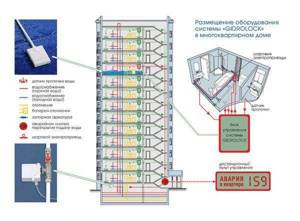
Modern heating of new buildings.
Due to the fact that the kitchen in old houses is not very large, plus it is naturally heated by periodic operation of the stove, the permissible minimum temperature in it is +18 ºС.
Important: all the above data is valid for apartments located in the central part of the building. For side apartments, where most of the walls are external, the instructions prescribe an increase in temperature above the standard by 2 - 5 ºС

Heating standards by region.
Requirements for chimney installation
When installing a gas boiler of any type in an apartment in an apartment building, the chimney cannot be made narrower than its outlet pipe. If the device has an open combustion chamber and a power of no more than 30 kW, the cross-section of the chimney pipe cannot be less than 140 millimeters, and with a productivity of 40 kW - 160 millimeters in diameter.
If the boiler has a closed combustion chamber, it is equipped with a coaxial chimney with a cross-sectional size recommended by the manufacturer.
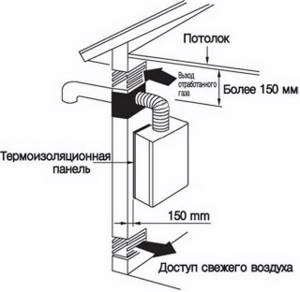
Next you need to adhere to the following rules:
- the pipe going upward from the wall-mounted gas unit must have a length of at least 50 centimeters, and only then can the elbow be installed;
- more than three bends cannot be created along the entire length of the chimneys;
- combustion products from appliances with open combustion chambers are removed into the chimney, and with closed ones, also into the chimney or through the wall directly to the street (the method depends on the project).
Central heating of apartment buildings
Through main pipelines, coolant from the central boiler room is supplied to the heating unit of an apartment building and is further distributed among the apartments. In this case, additional adjustment of the degree of hot water supply is carried out directly at the heating point, for which circular pumps are used. This method of supplying coolant to the end consumer is called independent (more details: “Central heating is both pros and cons”).
In addition, dependent heating systems are used in apartment buildings. In this case, the coolant is transported to apartment radiators without additional distribution directly from the thermal power plant. In this case, the water temperature is determined regardless of whether it is supplied through a distribution point or directly to consumers.

Date: September 25, 2021
Types of optimization of central heating operation
Everyone knows that the coolant passing through a pipe system loses most of its temperature, which characterizes the need to optimize the operation of the heating system to reduce heat loss.
This problem can be solved using one of several options. The first method will be suitable if the boiler room and the entire pipe system are fully regulated by the owners themselves. In this case, improvements could be as follows:
- installation of a more modern and efficient unit with high performance characteristics. As a result, the pressure in the central heating system will change, fuel consumption and cash costs will decrease;
- the ability to provide the system pipeline with high-quality insulating material, which will reduce heat loss as it moves to the batteries. Moreover, the thermal insulation material will protect the entire structure from possible freezing, which is very important in cold winter conditions.

The essence of the second option is as follows: the thermal energy supplied by the boiler house or thermal power plant to a specific living room is strictly controlled. Typically, this option involves installing special energy-saving meters. All further payments for heating services will be reproduced solely on the basis of their readings.
Block boiler room in a residential building
The situation for this type of heating system looks much better. The funds are invested because construction companies must deliver the house, and without a heating system this will not be possible. Since heating networks place high demands on heating systems, they have to meet them. The efficiency is quite high, since there is no need to transport heat. But as far as property is concerned, a question arises. On the one hand, the owners are all the owners of apartments in a residential building. But in fact, when equipment breaks down, people do not want to invest in it, since, after all, it is common and not their personal. Maintenance of block boiler houses is carried out; private companies are responsible for it and are ready to take on such work. Usually these are the same companies that were involved in the installation and commissioning of the system. Another question: who will pay for it? Let's leave the question unanswered, since this type of activity is not very profitable and requires significant costs. However, heating systems with block boiler houses provide a high level of comfort, but not on an individual basis, although it is higher than in the case of central heating. In order to create ideal conditions for yourself, you will have to buy quite expensive equipment, such as thermostatic heads.
Registration of permission
Rules for the provision of utility services
There is a misconception that issuing permits for an apartment with apartment heating is almost impossible to do. However, to do this you only need to know the basic laws and adhere to technical standards.
According to paragraph 44 of the Government of the Russian Federation Resolution No. 307, gas boilers with the following characteristics are allowed for installation as heating equipment in apartment buildings.
- Closed combustion chamber;
- Device for monitoring the state of the flame in a gas burner - automation system;
- The operating temperature should not exceed 95°C, and the maximum pressure in the pipeline is 1 MPa.
Advice. To select the optimal boiler model, it is recommended to contact the gas management company that services the house. Their representatives must provide requirements for this equipment.
The following actions should then be taken.
Obtaining Technical Specifications from Gorgaz
To do this, you must provide a package of documents confirming ownership of the premises - a passport from the BTI, a purchase and sale agreement, personal data. Within 14 days, representatives of the organization are required to issue specifications, which include an apartment heating scheme.
You must obtain permission from the fire department, which will inspect the ventilation ducts in the house. If the project initially included the installation of gas equipment, there will be no problems with this document.
Project part
Having received the technical conditions and permission from the fire service, you need to find a design organization to draw up an autonomous heating plan. These services are offered by a management organization or any other commercial company that has the appropriate certificates and permits. You cannot do this part of the work yourself, since houses with apartment heating must comply with current safety standards.
The project document contains an apartment heating scheme, a list of equipment and consumables. For each of them there must be a passport, and in case of its absence, technical information confirmed by the manufacturer and seller. If the house previously had central heating, then the risers are most often left. The plan indicates the location of disconnection from the network, the location of the gas boiler, the diagram of the main line and radiators.
Installation
The entire package of documents is submitted to the administration, which must verify their compliance with technical conditions. After receiving a positive decision, you can begin installing the equipment. It is noteworthy that most reviews about apartment heating at the design stage have a negative connotation, since bureaucracy and paperwork takes a lot of time and money.
Important. It is prohibited to connect the boiler to the gas line yourself
This should only be done by city gas representatives.
Having installed the elements of gas apartment heating, you can proceed to the stage of agreeing on the time of connection to the main line. Representatives of the management company must check the condition of the installed system and issue a certificate of compliance. Then the boiler is connected to the gas pipe and the integrity and correct operation of the system are checked.
Step-by-step instruction
The transition to personal heating entails re-equipping networks, devices and making changes to the facility’s passport.

In the language of lawyers, this is called “reorganization” and implies the following algorithm of actions:
- Project development.
- Getting permission.
- Installation of equipment and installation of utility networks.
- Commissioning.
On a note! Chapter 4 of the Housing Code describes in detail all legal grounds for redevelopment, refusal and consequences of unauthorized reconstruction.
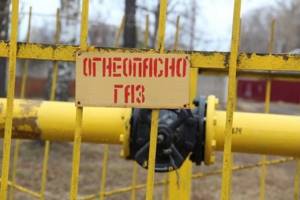
Photo: Alexander Mineev
To begin, prepare:
- application form;
- originals or notarized copies of documents for the apartment;
- change plan. Developed by competent organizations;
- technical certificate of the premises. It is issued by BTI;
- written consent of family members;
- the decision of 100% of the owners of the house is formalized based on the results of the general meeting in the minutes;
- conclusion of the commission for the protection of architectural monuments and cultural heritage. Compiled only if the building is included in the category of such.
Coordination
Before bringing a complete package of documents to the mayor's office, you need to come to an agreement with your neighbors. Considering that the process affects common property, 100% of the owners must approve the idea. From Part 3 of Article 36 of the RF Housing Code it follows that until all of them sign the decision, there is no point in proceeding to the next step.
The issue is included in the meeting agenda and documented in minutes.
Issuance of permission from the authorities
This is handled by the housing and communal services department or department, which is reluctant to approve documentation. The official reason is that the project does not comply with current standards. In fact, officials do not want to take responsibility for a potential boiler explosion due to improper operation. There are plenty of examples around the country, so administration employees do not want to voluntarily sign a criminal case.
On a note! The design process is very expensive, so it is better to entrust it to proven specialists. It doesn’t hurt to check the company’s reputation and ask for examples of work that have successfully passed the examination of the municipality.
Obtaining sanction from RSO
Energy suppliers are not very happy to issue such papers. There is a risk of worsening the living conditions of neighbors. Due to incorrect calculations, there is often a disruption in the central heating supply in apartment buildings and a decrease in the heat level in adjacent apartments. Boiler house owners cannot allow this to happen.

Photo: Alexander Mineev
Another reason is that heating network companies do not benefit from the outflow of customers, which entails a decrease in income.
However, if residents are confident in the correctness of the presented figures, then they can try to challenge the decision of the city leadership in court.
Would you like to install individual heating in your apartment?
Not really
Selecting the necessary equipment
The ideal heat source for an individual system, according to experts, is a double-circuit gas-fired boiler with a closed combustion chamber. Of course, you can get by with a single-circuit one - but only if there are really no interruptions in the supply of hot water in your house. Otherwise, it is better to “kill two birds with one stone.”
The advantages of such equipment include a multi-level security system, silent operation, reasonable price, and compactness.
If desired, you can set up an autonomous system based on an electric boiler, however, for its successful and comfortable operation, the meter must be multi-tariff, and the wiring must be “fresh” and of high quality (preferably copper). This system is easy to install, hygienic, silent, efficient, and aesthetically pleasing. But electricity is an expensive energy resource, so you should think carefully before deciding in favor of an electric unit.
Having decided on the type of heating equipment, you need to select the optimal model for your home based on its technical characteristics. In addition to the nominal heating area from the technical description of the device, the characteristics of the room should be taken into account. The condition of the apartment must be taken as critically as possible. After all, you must admit, it’s one thing when you have heated floors, sealed windows, good doors, and quite another when it comes from all the cracks.
You can choose almost any radiators on the market. Both steel, aluminum, and bimetallic ones demonstrate good efficiency. Old cast iron batteries are definitely not worth leaving behind.
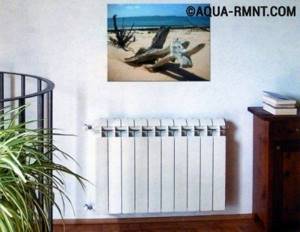
It is advisable to buy polypropylene pipes; If you are not limited in funds, you can take copper ones. But, in general, in terms of price-quality ratio, polypropylene pipes are the best choice.
You can carry out individual heating yourself - there is nothing complicated about laying pipes and installing radiators. What should definitely be entrusted to professionals is the gas supply, installation and startup of the boiler, and checking the system for leaks.
How much will it cost to install an autonomous system? It is very difficult to even talk about approximate amounts, since too many factors influence the final cost of the “event”: the size of the apartment, the brand and functionality of the boiler, the material of the pipes, prices for specialist services, the complexity and volume of work.
Only one thing can be said for sure: individual heating in an apartment building is incredible convenience and comfort, which in any case is worth the money spent.

